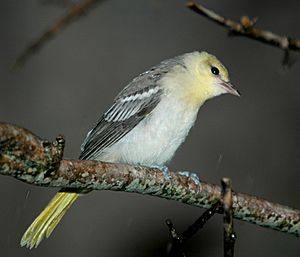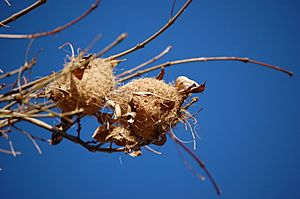Bullock's oriole facts for kids
Quick facts for kids Bullock's oriole |
|
|---|---|
 |
|
| Male | |
 |
|
| Female | |
| Conservation status | |
| Scientific classification | |
| Genus: |
Icterus
|
| Species: |
bullockii
|
 |
|
| Range of I. bullockii Breeding range Wintering range | |
Bullock's orioles (scientific name: Icterus bullockii) are small, colorful birds from North America. They belong to a group of birds sometimes called "New World blackbirds." For a while, people thought Bullock's orioles and Baltimore orioles were the same bird, called the "northern oriole." This bird got its name from William Bullock, an English person who loved studying nature.
Contents
Description
Bullock's orioles show "sexual dimorphism." This means that male and female birds look different. Males are usually brighter and more colorful than females. Adult males are also a bit bigger and heavier than females.
Measurements:
- Length: 6.7 to 7.5 inches (17 to 19 cm)
- Weight: 1.0 to 1.5 ounces (29 to 43 g)
- Wingspan: 12.2 inches (31 cm)
Adult orioles have a pointed beak. Their skin, claws, and beak are black. The bottom part of their beak might be bluish-gray.
Male Bullock's orioles have bright orange and black feathers. They have a black patch on their throat and a white stripe on their wings. Their belly, chest, and face are orange or yellow. Their back, wings, and tail are black. A black line goes from each eye to the top of their head. The feathers on their wings have white edges, making a wing patch. Their tail is mostly black, but the outer feathers have orange tips, forming a "T" shape.
Female Bullock's orioles look different. Their upper body is gray-brown. Their chest and belly are a duller yellow. The top of their head is olive green. Some females might have a small dark patch on their throat, like males, but it's smaller. Females do not have the black line near their eyes that males have. Scientists think older female birds might have these throat patches.
Young male Bullock's orioles look a lot like adult females. Young birds (juveniles) look like adult females but have darker wings and a pink or whitish beak. It's hard to tell young males and females apart just by looking at them.
Reproduction
Bullock's orioles usually have one partner during the breeding season. This season typically runs from May to July. The exact start time changes depending on where the birds live. In colder, western areas, breeding starts later.
Both male and female orioles work together to build their nests. They weave deep, hanging nests that look like baskets. Females do most of the building. They lay between three and six eggs in these nests. The nests are made from plant fibers, like bark and grass. They also use animal hair. The inside of the nest is soft, lined with down, hair, and moss.
Both parents help raise the young birds. They also protect their nest from animals that might try to eat the eggs or babies.
Sometimes, Bullock's orioles and Baltimore orioles have babies together. This usually happens in the Midwest, where their living areas overlap.
Communication
Both male and female Bullock's orioles sing. Males have a sweeter song, but females sing more often. Their song is similar to the Baltimore oriole's song, but it is faster and sounds a bit harsher.
Distribution
Bullock's orioles live in western North America. Sometimes, they fly to the eastern part of the continent by accident. During the breeding season, you can find them as far west as the eastern mountains of the Cascade Range. Their breeding area goes east to the Dakotas, Kansas, and northern Central Texas.
They can be found as far north as British Columbia in Canada. They also live as far south as Sonora or Durango in Mexico. These birds are common in their range. However, they are not found in parts of Arizona and Idaho. This is because those areas are too high up and too dry for them to live comfortably.
In winter, these birds fly south to Mexico and northern Central America. Their winter home stretches from Sinaloa to Oaxaca.
Behavior
Habitat
Like other birds in their family, Bullock's orioles like to live at the edges of different habitats. They especially like areas near rivers, open forests with trees that lose their leaves, and scrub forests. During breeding season, they prefer places with lots of cottonwood, pecan, and willow trees (if near water). In dry areas, they like salt cedar and mesquite trees. In California, they use eucalyptus trees for nectar.
Diet
These birds look for food in trees and bushes. They also fly short distances to catch insects. Their main diet includes insects, berries, and nectar from flowers. They also eat other fruits like oranges and sometimes grapes. In some places, you might see them drinking from hummingbird feeders.
These birds also enjoy eating grape jelly from a dish. Parents will bring their young birds to the jelly dish. They feed them jelly, and then the adult males leave the area. The young birds will stay at the jelly dish from early July until late September.
Related species
For a while, scientists thought Bullock's orioles and Baltimore orioles were the same species. But later studies showed they were different. These studies looked at how they breed, when they change their feathers, and their DNA. This proved that Bullock's orioles are their own unique species.
- BirdLife species factsheet for Icterus bullockii
- Lua error in Module:EditAtWikidata at line 29: attempt to index field 'wikibase' (a nil value).
- Audio recordings of Bullock's oriole on Xeno-canto.
See also
 In Spanish: Turpial de ojo rayado para niños
In Spanish: Turpial de ojo rayado para niños



